Catalan number
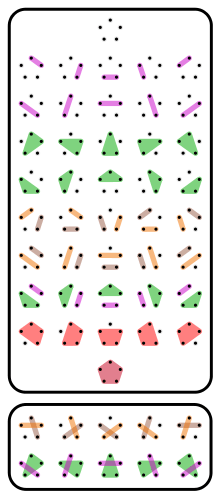
In combinatorial mathematics, the Catalan numbers form a sequence of natural numbers that occur in various counting problems, often involving recursively-defined objects. They are named after the Belgian mathematician Eugène Charles Catalan (1814–1894).
Using zero-based numbering, the nth Catalan number is given directly in terms of binomial coefficients by
The first Catalan numbers for n = 0, 1, 2, 3, … are
- 1, 1, 2, 5, 14, 42, 132, 429, 1430, 4862, 16796, 58786, 208012, 742900, 2674440, 9694845, 35357670, 129644790, 477638700, 1767263190, 6564120420, 24466267020, 91482563640, 343059613650, 1289904147324, 4861946401452, … (sequence A000108 in the OEIS).
Properties
An alternative expression for Cn is
which is equivalent to the expression given above because . This shows that Cn is an integer, which is not immediately obvious from the first formula given. This expression forms the basis for a proof of the correctness of the formula.
The Catalan numbers satisfy the recurrence relation
moreover,
This is because since choosing n numbers from a 2n set of numbers can be uniquely divided into 2 parts: choosing i numbers out of the first n numbers and then choosing n-i numbers from the remaining n numbers.
They also satisfy:
which can be a more efficient way to calculate them.
Asymptotically, the Catalan numbers grow as
in the sense that the quotient of the nth Catalan number and the expression on the right tends towards 1 as n → +∞. Some sources use just .[1] (This can be proved by using Stirling's approximation for n!.)
The only Catalan numbers Cn that are odd are those for which n = 2k − 1. All others are even.
The only prime Catalan numbers are C2 = 2 and C3 = 5.[2]
The Catalan numbers have an integral representation
where This means that the Catalan numbers are a solution of the Hausdorff moment problem on the interval [0, 4] instead of [0, 1]. The orthogonal polynomials having the weight function on are
Applications in combinatorics
There are many counting problems in combinatorics whose solution is given by the Catalan numbers. The book Enumerative Combinatorics: Volume 2 by combinatorialist Richard P. Stanley contains a set of exercises which describe 66 different interpretations of the Catalan numbers. Following are some examples, with illustrations of the cases C3 = 5 and C4 = 14.

- Cn is the number of Dyck words[3] of length 2n. A Dyck word is a string consisting of n X's and n Y's such that no initial segment of the string has more Y's than X's. For example, the following are the Dyck words of length 6:
- Re-interpreting the symbol X as an open parenthesis and Y as a close parenthesis, Cn counts the number of expressions containing n pairs of parentheses which are correctly matched:
- Cn is the number of different ways n + 1 factors can be completely parenthesized (or the number of ways of associating n applications of a binary operator). For n = 3, for example, we have the following five different parenthesizations of four factors:
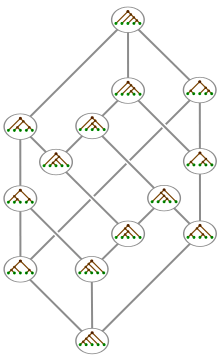
- Successive applications of a binary operator can be represented in terms of a full binary tree. (A rooted binary tree is full if every vertex has either two children or no children.) It follows that Cn is the number of full binary trees with n + 1 leaves:

- Cn is the number of non-isomorphic ordered trees with n vertices. (An ordered tree is a rooted tree in which the children of each vertex are given a fixed left-to-right order.)[4]
- Cn is the number of monotonic lattice paths along the edges of a grid with n × n square cells, which do not pass above the diagonal. A monotonic path is one which starts in the lower left corner, finishes in the upper right corner, and consists entirely of edges pointing rightwards or upwards. Counting such paths is equivalent to counting Dyck words: X stands for "move right" and Y stands for "move up".
The following diagrams show the case n = 4:
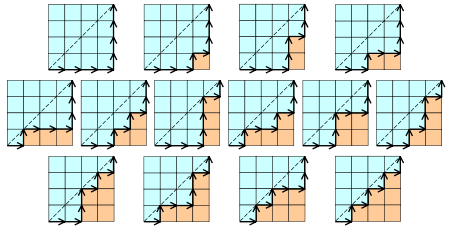
This can be succinctly represented by listing the Catalan elements by column height:[5]
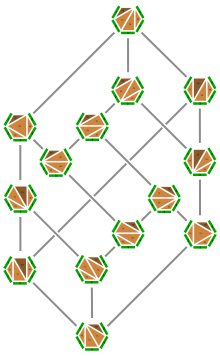
- Cn is the number of different ways a convex polygon with n + 2 sides can be cut into triangles by connecting vertices with straight lines (a form of Polygon triangulation). The following hexagons illustrate the case n = 4:

- Cn is the number of stack-sortable permutations of {1, ..., n}. A permutation w is called stack-sortable if S(w) = (1, ..., n), where S(w) is defined recursively as follows: write w = unv where n is the largest element in w and u and v are shorter sequences, and set S(w) = S(u)S(v)n, with S being the identity for one-element sequences. These are the permutations that avoid the pattern 231.
- Cn is the number of permutations of {1, ..., n} that avoid the pattern 123 (or any of the other patterns of length 3); that is, the number of permutations with no three-term increasing subsequence. For n = 3, these permutations are 132, 213, 231, 312 and 321. For n = 4, they are 1432, 2143, 2413, 2431, 3142, 3214, 3241, 3412, 3421, 4132, 4213, 4231, 4312 and 4321.
- Cn is the number of noncrossing partitions of the set {1, ..., n}. A fortiori, Cn never exceeds the nth Bell number. Cn is also the number of noncrossing partitions of the set {1, ..., 2n} in which every block is of size 2. The conjunction of these two facts may be used in a proof by mathematical induction that all of the free cumulants of degree more than 2 of the Wigner semicircle law are zero. This law is important in free probability theory and the theory of random matrices.
- Cn is the number of ways to tile a stairstep shape of height n with n rectangles. The following figure illustrates the case n = 4:

- Cn is the number of rooted binary trees with n internal nodes (n + 1 leaves or external nodes). Illustrated in following Figure are the trees corresponding to n = 0,1,2 and 3. There are 1, 1, 2, and 5 respectively. Here, we consider as binary trees those in which each node has zero or two children, and the internal nodes are those that have children.
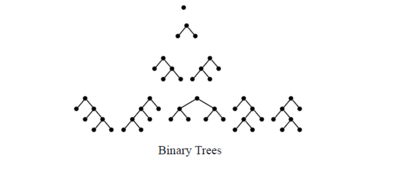
- Cn is the number of ways to form a “mountain ranges” with n upstrokes and n down-strokes that all stay above the original line.The mountain range interpretation is that the mountains will never go below the horizon.
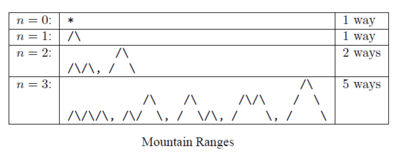
- Cn is the number of standard Young tableaux whose diagram is a 2-by-n rectangle. In other words, it is the number of ways the numbers 1, 2, ..., 2n can be arranged in a 2-by-n rectangle so that each row and each column is increasing. As such, the formula can be derived as a special case of the hook-length formula.
- Cn is the number of ways that the vertices of a convex 2n-gon can be paired so that the line segments joining paired vertices do not intersect. This is precisely the condition that guarantees that the paired edges can be identified (sewn together) to form a closed surface of genus zero (a topological 2-sphere).
- Cn is the number of semiorders on n unlabeled items.[6]
- In chemical engineering Cn is the number of possible separation sequences which can separate a mixture of n components.[7]
Proof of the formula
There are several ways of explaining why the formula
solves the combinatorial problems listed above. The first proof below uses a generating function. The other proofs are examples of bijective proofs; they involve literally counting a collection of some kind of object to arrive at the correct formula.
First proof
We first observe that all of the combinatorial problems listed above satisfy Segner's[8] recurrence relation
For example, every Dyck word w of length ≥ 2 can be written in a unique way in the form
- w = Xw1Yw2
with (possibly empty) Dyck words w1 and w2.
The generating function for the Catalan numbers is defined by
The two recurrence relations together can then be summarized in generating function form by the relation
in other words, this equation follows from the recurrence relations by expanding both sides into power series. On the one hand, the recurrence relations uniquely determine the Catalan numbers; on the other hand, the generating function solution
has a power series at 0 and its coefficients must therefore be the Catalan numbers. The chosen solution satisfies the following condition.
The other solution has a pole at 0 and this reasoning doesn't apply to it.
The square root term can be expanded as a power series using the identity
This is a special case of Newton's generalized binomial theorem; as with the general theorem, it can be proved by computing derivatives to produce its Taylor series. Setting y = −4x and substituting this power series into the expression for c(x) and shifting the summation index n by 1, the expansion simplifies to
The coefficients are now the desired formula for Cn.
Another way to get c(x) is to solve for xc(x) and observe that appears in each term of the power series.
Second proof
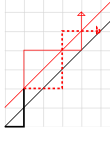
This proof depends on a trick known as André's reflection method, which was originally used in connection with Bertrand's ballot theorem. (The reflection principle has been widely attributed to Désiré André, but his method did not actually use reflections; and the reflection method is a variation due to Aebly and Mirimanoff.[9]) We count the paths which start and end on the diagonal of the n × n grid. All such paths have n rightward and n upward steps. Since we can choose which of the 2n steps are upward (or, equivalently, rightward) ones, there are total monotonic paths of this type. A bad path will cross the main diagonal and touch the next higher (fatal) diagonal (depicted red in the illustration). We flip the portion of the path occurring after that touch about that fatal diagonal, as illustrated; this geometric operation amounts to interchanging all the rightward and upward steps after that touch. In the section of the path that is not reflected, there is one more upward step than rightward steps, so the remaining section of the bad path has one more rightward than upward step (because it ends on the main diagonal). When this portion of the path is reflected, it will also have one more upward step than rightward steps. Since there are still 2n steps, there must now be n + 1 upward steps and n - 1 rightward steps. So, instead of reaching the target (n,n), all bad paths (after the portion of the path is reflected) will end in location (n - 1, n + 1). As any monotonic path in the n - 1 × n + 1 grid must meet the fatal diagonal, this reflection process sets up a bijection between the bad paths of the original grid and the monotonic paths of this new grid because the reflection process is reversible. The number of bad paths is therefore,
and the number of Catalan paths (i.e., good paths) is obtained by removing the number of bad paths from the total number of monotonic paths of the original grid,
In terms of Dyck words, we start with a (non-Dyck) sequence of n X's and n Y's and interchange all X's and Y's after the first Y that violates the Dyck condition. At that first Y, there are k + 1 Y's and k X's for some k between 1 and n - 1.
Third proof
The following bijective proof, while being more involved than the previous one, provides a more natural explanation for the term n + 1 appearing in the denominator of the formula for Cn. A generalized version of this proof can be found in a paper of Rukavicka Josef (2011).[10]
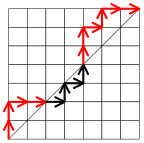
Suppose we are given a monotonic path, which may happen to cross the diagonal. The exceedance of the path is defined to be the number of vertical edges which lie above the diagonal. For example, in Figure 2, the edges lying above the diagonal are marked in red, so the exceedance of the path is 5.
Now, if we are given a monotonic path whose exceedance is not zero, then we may apply the following algorithm to construct a new path whose exceedance is one less than the one we started with.
- Starting from the bottom left, follow the path until it first travels above the diagonal.
- Continue to follow the path until it touches the diagonal again. Denote by X the first such edge that is reached.
- Swap the portion of the path occurring before X with the portion occurring after X.
The following example should make this clearer. In Figure 3, the black dot indicates the point where the path first crosses the diagonal. The black edge is X, and we swap the red portion with the green portion to make a new path, shown in the second diagram.
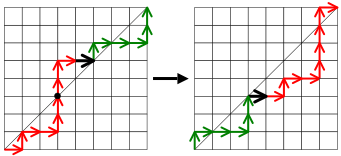
Notice that the exceedance has dropped from three to two. In fact, the algorithm will cause the exceedance to decrease by one, for any path that we feed it, because the first vertical step starting on the diagonal (at the point marked with a black dot) is the unique vertical edge that under the operation passes from above the diagonal to below it; all other vertical edges stay on the same side of the diagonal.

It is also not difficult to see that this process is reversible: given any path P whose exceedance is less than n, there is exactly one path which yields P when the algorithm is applied to it. Indeed, the (black) edge X, which originally was the first horizontal step ending on the diagonal, has become the last horizontal step starting on the diagonal.
This implies that the number of paths of exceedance n is equal to the number of paths of exceedance n − 1, which is equal to the number of paths of exceedance n − 2, and so on, down to zero. In other words, we have split up the set of all monotonic paths into n + 1 equally sized classes, corresponding to the possible exceedances between 0 and n. Since there are
monotonic paths, we obtain the desired formula
Figure 4 illustrates the situation for n = 3. Each of the 20 possible monotonic paths appears somewhere in the table. The first column shows all paths of exceedance three, which lie entirely above the diagonal. The columns to the right show the result of successive applications of the algorithm, with the exceedance decreasing one unit at a time. There are five rows, that is, C3 = 5.
Fourth proof
This proof uses the triangulation definition of Catalan numbers to establish a relation between Cn and Cn+1. Given a polygon P with n+ 2 sides, first mark one of its sides as the base. If P is then triangulated, we can further choose and orient one of its 2n+1 edges. There are (4n+2)Cn such decorated triangulations. Now given a polygon Q with n+3 sides, again mark one of its sides as the base. If Q is triangulated, we can further mark one of the sides other than the base side. There are (n+2)Cn+1 such decorated triangulations. Then there is a simple bijection between these two kinds of decorated triangulations: We can either collapse the triangle in Q whose side is marked, or in reverse expand the oriented edge in P to a triangle and mark its new side. Thus
The binomial formula for Cn follows immediately from this relation and the initial condition C1 = 1.
Fifth proof
This proof is based on the Dyck words interpretation of the Catalan numbers, so Cn is the number of ways to correctly match n pairs of brackets. We denote a (possibly empty) correct string with c and its inverse (where "[" and "]" are exchanged) with c+. Since any c can be uniquely decomposed into c = [ c1 ] c2, summing over the possible spots to place the closing bracket immediately gives the recursive definition
Now let b stand for a balanced string of length 2n—that is, containing an equal number of "[" and "]"—and with some factor dn ≥ 1. As above, any balanced string can be uniquely decomposed into either [ c ] b or ] c+ [ b, so
Also, any incorrect balanced string starts with c ], so
Subtracting the above equations and using Bi = di Ci gives
Comparing coefficients with the original recursion formula for Cn gives di = i + 1, so
Hankel matrix
The n×n Hankel matrix whose (i, j) entry is the Catalan number Ci+j−2 has determinant 1, regardless of the value of n. For example, for n = 4 we have
Moreover, if the indexing is "shifted" so that the (i, j) entry is filled with the Catalan number Ci+j−1 then the determinant is still 1, regardless of the value of n. For example, for n = 4 we have
Taken together, these two conditions uniquely define the Catalan numbers.
History
The Catalan sequence was described in the 18th century by Leonhard Euler, who was interested in the number of different ways of dividing a polygon into triangles. The sequence is named after Eugène Charles Catalan, who discovered the connection to parenthesized expressions during his exploration of the Towers of Hanoi puzzle. The counting trick for Dyck words was found by D. André in 1887.
In 1988, it came to light that the Catalan number sequence had been used in China by the Mongolian mathematician Mingantu by 1730.[11][12] That is when he started to write his book Ge Yuan Mi Lu Jie Fa, which was completed by his student Chen Jixin in 1774 but published sixty years later. P.J. Larcombe (1999) sketched some of the features of the work of Mingantu, including the stimulus of Pierre Jartoux, who brought three infinite series to China early in the 1700s.
For instance, Ming used the Catalan sequence to express series expansions of sin(2α) and sin(4α) in terms of sin(α).
Generalizations
The two-parameter sequence of non-negative integers is a generalization of the Catalan numbers. These are named super-Catalan numbers, by Ira Gessel. These number should not confused with the Schröder–Hipparchus numbers, which sometimes are also called super-Catalan numbers.
For , this is just two times the ordinary Catalan numbers, and for , the numbers have an easy combinatorial description. However, other combinatorial descriptions are only known[13] for and , and it is an open problem to find a general combinatorial interpretation.
See also
Notes
- ↑ Cormen, Thomas H.; Leiserson, Charles E.; Rivest, Ronald L. (1990). "Dynamic Programming". Introduction to Algorithms. Cambridge, Massachusetts: The MIT Press. p. 304. ISBN 0262031418.
- ↑ Koshy, Thomas; Salmassi, Mohammad (2006). Parity and primality of Catalan numbers. The Mathematical Association of America.
- ↑ Equivalent definitions of Dyck paths
- ↑ Stanley p.221 example (e)
- ↑ Črepinšek, Matej; Mernik, Luka (2009). "An efficient representation for solving Catalan number related problems" (PDF). International Journal of Pure and Applied Mathematics. 56 (4): 589–604.
- ↑ Kim, K. H.; Roush, F. W. (1978), "Enumeration of isomorphism classes of semiorders", Journal of Combinatorics, Information &System Sciences, 3 (2): 58–61, MR 538212.
- ↑ Thompson, R. W.; King, C. J. (1972), "Systematic synthesis of separation schemes", American Institution of Chemical Engineers Journal, 18 (5): 941–948.
- ↑ A. de Segner, Enumeratio modorum, quibus figurae planae rectilineae per diagonales dividuntur in triangula. Novi commentarii academiae scientiarum Petropolitanae 7 (1758/59) 203–209.
- ↑ Renault, Marc, Lost (and found) in translation: André's actual method and its application to the generalized ballot problem. Amer. Math. Monthly 115 (2008), no. 4, 358--363.
- ↑ Rukavicka Josef (2011), On Generalized Dyck Paths, Electronic Journal of Combinatorics online
- ↑ The 18th century Chinese discovery of the Catalan numbers
- ↑ Ming Antu, the First Inventor of Catalan Numbers in the World
- ↑ Chen, Xin. "The super Catalan numbers S(m,m+s) for s<=3 and some integer factorial ratios" (PDF). www-users.math.umn.edu/~reiner/REU/ChenWang2012.pdf. Retrieved 26 September 2014.
References
- Conway and Guy (1996) The Book of Numbers. New York: Copernicus, pp. 96–106.
- Gardner, Martin (1988), Time Travel and Other Mathematical Bewilderments, New York: W.H. Freeman and Company, pp. 253–266 (Ch. 20), ISBN 0-7167-1924-X
- Koshy, Thomas (2008), Catalan Numbers with Applications, Oxford University Press, ISBN 0-19-533454-X
- Koshy, Thomas & Zhenguang Gao (2011) "Some divisibility properties of Catalan numbers", Mathematical Gazette 95:96–102.
- Larcombe, P.J. (1999) "The 18th century Chinese discovery of the Catalan numbers", Mathematical Spectrum 32:5–7.
- Stanley, Richard P. (1999), Enumerative combinatorics. Vol. 2, Cambridge Studies in Advanced Mathematics, 62, Cambridge University Press, ISBN 978-0-521-56069-6, MR 1676282
- Egecioglu, Omer (2009), A Catalan-Hankel Determinant Evaluation (PDF)
External links
- Stanley, Richard P. (1998), Catalan addendum to Enumerative Combinatorics, Volume 2 (PDF)
- Weisstein, Eric W. "Catalan Number". MathWorld.
- Dickau, Robert M.: Catalan numbers Further examples.
- Davis, Tom: Catalan numbers. Still more examples.
- Schmidthammer, Jürgen: Catalan-Zahlen Zulassungsarbeit zum Staatsexamen (PDF-File; 7,05 MB)
- "Equivalence of Three Catalan Number Interpretations" from The Wolfram Demonstrations Project
- Dyck paths and binary trees in the FindStat database
- https://www.youtube.com/watch?v=pEJo0DJhYvU (Movie: generating all correct strings of parentheses with backtracking method in C language)